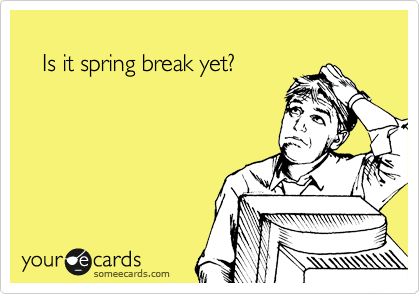Dear Spring Break,
You came! And yet, I never thought you would. The two weeks
leading up to your arrival felt like 1,000 years; I didn’t think you would come! But once you were here, you
gave me a lot to reflect on.
It all started on March 24.
You see, Spring Break Eve can be a dreaded time in school. It’s a test run for June 22, 2016, anticipating when the second
hand will strike the “11” on the clock and the bell rings at 2:25pm. Kids don’t
want to do ANYTHING; teachers don’t want to do anything either, so it seems
like the day could lead to mass chaos.
Only, you were quite the opposite.
While no, the kids didn’t want to do anything, they were still
cooperative enough to read for the 30 minutes that I requested from them. I asked each student how many post its he/she
wanted – and the average was “2”.
“Okay,” I thought to myself.
“Students are getting into the habit of doing post its."
I decided back in January to give students 2 post its each
day. If they didn’t independently
complete a post it or track their thinking, I would stop them 15-20 minutes
through our reading, half way, and remind them to be jotting an idea, not a summary. While we still have some work to do in that
department, I was still impressed that when given the choice, students didn’t
say “One please!” J
What I realized twenty-four days into March and upon your
arrival is that kids need time to read.
I know my students – I know that the majority of my 50 kids will NOT go home and read whether I assign
it or not. That’s why I don’t assign
reading and I don’t assign reading responses for homework. Kids aren’t genuine in putting forth the
time. Reading and reading responses are
more hassle than they are fun and reflectory (let’s make up a new word).
I nearly fell over during my first class. A student who has not enjoyed reading found
the right book, picked up The Outsiders earlier this month. He picked it up underneath the desk he was
sitting in. He had nothing else to read,
so he went with it for the 30 minutes of reading that day. And yet, the next day he was reading it. And the next day. And by the time I knew it, he was 100 pages
in. Then he finished it, and I panicked
because he enjoyed the book and I needed wanted him to read something else!
“What am I going to do?!” I thought …
I reached out to a
friend, one who had experience with middle schoolers and more teaching wisdom
than I have acquired, and she recommended more books by S.E. Hinton. I sent the
kid to the library and he checked out another S.E. Hinton book.
Then a week later, he finished the second book.
So, he took it upon himself to go back to the library to get
a third book. And he walked into class
on Tuesday and told me he read at home.
What? Did I hear you
correctly?
I slowly stood up to look around my classroom. I was no longer looking at it through the
lens of “Who-isn’t-reading?” But it became the lens of “Who-is-reading?”
I noticed three things:
1)
students were reading
2)
students were writing on post its
3)
students were sketching in their notebooks
also known as ...
I approached another student. “Can I interrupt your reading?”
“Sure,” she replied with a smile across her face.
I hesitated. “What did you do last year?”
“Well, my teacher gave us ______, and we had to do
_________. I didn’t like it though; it
made me feel like a third grader. This
year is better. You give us time to read
and you let us write about our reading.”
We were three weeks into the month of March and I came to
realize the impact of setting a goal and staying faithful to that goal.
I had set a goal to do stop and jots, and I had set a goal to have
students RECORD THEIR READING. I didn’t
care how much they hated it, but I did explain why I needed it recorded.
- I know how many pages you are getting through in the time that you are making for reading during class.
- I know how long it’s taking you to get through a book.
- I notice when you are into a book.
- I notice when you abandon a book – and how far you are into the book when you make that decision.
- I know your genre preference. J
I didn't want reading to just be something that they did. Rather, I wanted it to be enjoyable. I didn't want a reading log filled with lies. I wanted honesty. I wanted to know the genuineness of my classes. With that said, I realized I had accomplished something. I had won a battle. Students were doing what I asked them to do –
reading, stopping/jotting, and recording.
Hopefully they do grow to analyze the world a little more than just
superficially. Hopefully they transfer
what they learn in the classroom and learn how to apply it to their world. And for some, hopefully they learn that it’s
not that they don’t like reading, but that they haven’t found the right
book. Who knows, maybe I’ll grow more
readers like T -
“Eww! Miss Snyder, I’m turning into B [another student in
the class]! I’m reading too many books! I just read a book in 3 days! I only read 3 pages when I was in 4th grade! I don’t know what to do
with my life!”
The class chuckled. I
replied, “Idk T.. maybe pick up another book like the last two you picked up
after you cried the same story when your 5 book series ended?” ;)
Middle schoolers … What am I going to do with them? J





















0 comments:
Post a Comment